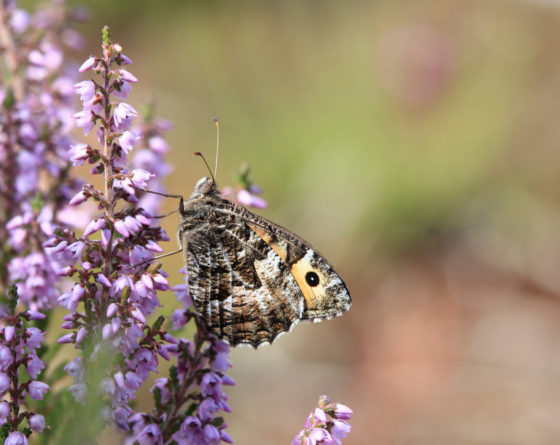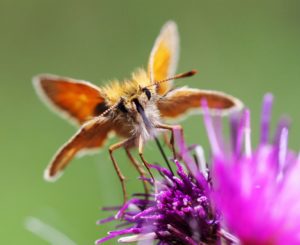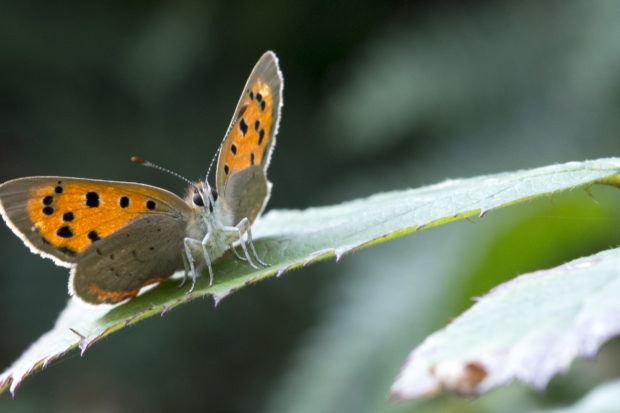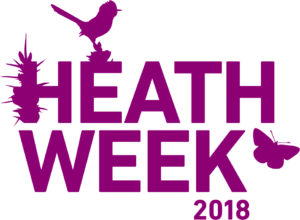Butterfly bonanza

Grayling butterfly taken by Rob Solomon
With over thirty species to be found across the Special Protection Area, the Thames Basin Heaths really is a haven for butterflies. A mixture of woodland, scrub, open areas of grassland and heath create the ideal habitat for a number of rare and common species. With the recent heat wave, now is a great time to get out and see them! One of our heathland specialists emerging over the last couple of weeks is the fantastically camouflaged Grayling. Although not quite as openly stunning as, say, the Purple Emperor or White Admiral, it is its cryptic colouring that makes this species special and what makes it one of my personal favourites! Grayling are the masters of disguise, perfectly employing the phrase ‘now-you-see-me-now-you-don’t’ they are able to disappear against a background of either bare earth or stones at a moment’s notice. Grayling will always rest with their wings closed and usually have the forewing hidden behind the hind-wing. When they first land, or when disturbed, the Grayling will briefly raise its forewing revealing dark eye spots that stand out against the beautiful spectrum of browns. Grayling are found on the heathland and coasts of southern England and can be in large colonies where ideal habitat is present, look out on any of the sandy or stony tracks across most of the Special Protection Area and you may just see one of these cryptic critters!

Small Skipper butterfly by Martin D’Arcy
Several Skipper species can be found across the Special Protection Area and some of these have been keeping our wardens entertained over the last week or so as they reach their peak. Large Skippers are probably the easiest to spot and identify, the most widespread ‘orange’ skipper in the UK, it flies at the same time as the similar Small and Essex Skippers and is distinguished by the faint chequered pattern on both sides of the wing. Look out for Large Skippers on Bramble flowers along woodland rides and clearings. Essex and Small Skippers are slightly harder to differentiate, not only do they look alike but they also share similar habitats and have the same flight period. The best way of telling them apart is by looking at the tip of the antennae, Small Skippers have orange-brown tips, while the Essex Skippers are always ink-black. So if you see someone kneelling down, straining to look at a small orange butterfly, you now know what they are doing!
Another orange butterfly to keep your eye out for around the Special Protection Area is the splendid Small Copper. Although a small species, the Small Copper is a quarrelsome and easily agitated butterfly, ready to take on any intruders that happen to enter its chosen sunny patch. Small Coppers thrive in hot and sunny conditions and in years when the weather is good there might be up to four broods. Aberrations (variations in the wing pattern) are quite common in Small Copper, sometimes these are only slight variations, such as the form Caeruleopunctata which have a row of small blue dots along the hind-wing. Or they could be as extreme as the albino form, where the copper is replaced with silvery white.

Small Copper butterfly by Jonathan Shavelar
Another species spotted on the Thames Basin Heaths recently is the elegant Purple Hairstreak. Although the UK’s most common Hairstreak it is often overlooked due to spending the majority of the flight period in the canopies of large Oak. They do occasionally come to lower levels to bask in the sunlight and unusually for Hairstreaks they rest with their wings open, giving lucky observers a chance to see this beautiful butterfly in all its glory!

There are so many species to be seen across our heathland, and surrounding woodlands, ranging from the stunning Silver-studded Blue to the discrete and cryptic Grayling and this time of year is the best time to get out and see them. Heath Week is fast approaching and we are running some guided walks around the Thames Basin Heaths that will give you the chance to see some of these beautiful creatures with the help of our resident experts and wardens. For more information on Heath Week and how to book onto these guided walks take a look here: https://www.tbhpartnership.org.uk/heath-week/.
As I have mentioned in previous blogs, if you want to contribute to the understanding and conservation of our native butterfly species you can record your sightings on the iRecord butterflies app here https://butterfly-conservation.org/our-work/recording-and-monitoring/irecord-butterflies.
Warden Conor
